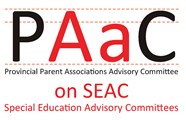Since 2010, the Ministry of Education has required school boards to complete a Special Education Plan Checklist to identify areas of the Special Education Plan that have been changed. The Special Education Plan Checklist is submitted to the Ministry by July 31st each year. The Special Education Plan should include information on the available special education programs and services as defined in Standards for School Boards’ Special Education Plans (2000).
The school board responsibilities under Regulation 464/97, and Regulation 306, Special Education Programs and Services, require SEAC to have a role in the development and review of the Special Education Plan. This means that SEAC should have input in the review of the Special Education Plan and provide advice to the Trustees.
Effective Practices to review the Special Education Plan include:
- Reviewing key documents, including Regulation 486/97, Regulation 306, the Standards for School Boards’ Special Education Plans (2000) and the components of the Special Education Plan Checklist.
- Developing an annual process for review of the Special Education Plan. This may include:
- Establishing a sub-committee that includes representatives from SEAC to review each section and make recommendations for changes
- Including a review of each section as part of the regular SEAC meetings
- Having presentations on specific programs and identifying what section of the Special Education Plan will need to be changed with changes and/or implementation of the program.
- Ensuring that the review process includes updating of statistical information, staffing, program locations and other information that may change annually.
- Providing SEAC an opportunity to review all of the changes and updates to the special Education Plan in conjunction with the special education budget before the end of each school year.
- Making a recommendation or motion regarding the Special Education Plan to create a record in the SEAC Minutes about SEAC participation in the review of the Special Education Plan. (See also Section 4.5 on making motions)
- Sharing of any comments, concerns or motions related to the Special Education Plan with the Trustees through the SEAC meeting Minutes, or a presentation to the Trustees. ( See also Section 3.0 on right to be heard)
Directives from the Ministry of Education, regarding the Special Education Plan, strongly encourage the school board to make the Special Education Plan accessible to the public in user-friendly format, on their public website.
Effective Practices to ensure the Special Education Plan is accessible and easy to understand include:
- Promoting the opportunity for public consultation on the special Education Plan. (See also Section 3.8)
- Providing suggestions as to how the information can be made accessible to parents, students and the general public.
- Making sure the Special Education Plan on the school board website is easy to find; providing printed copies at key locations, including school libraries, school offices, information displays and parent resource centers; and, developing a flyer or handout for parents.
- Translating the special Education Plan into other languages and formats, such as audio and Braille and/or providing information on who to contact for translated materials.
As part of Regulation 181/98, Identification and Placement of Exceptional Pupils, school boards are required to make available a parent guide that provides information about the Identification, Placement and Review Committee (IPRC) process. Some school boards also provide additional parent resource guides or brochures about the Individual Education Plan (IEP) process, or specific special education programs and services. PAAC on SEAC recommends that SEAC should be part of the process to develop or review the parent guides and other resources for parents.
SEAC can play an important role in the development of these parent resources to make sure they are easy to read, and that they provide information on additional resources for students or parents who want more information. SEAC can also provide advice on how the resources can be distributed or made available to students and parents.
Effective Practices to support the development and distribution of parent guides about the IPRC and IEP include:
- Establishing a sub-committee or ad hoc group to review all special education communication materials for parents.
- Requesting SEAC volunteers to join staff committees that are responsible for developing parent resources.
- Reviewing new parent guides and brochures as they are developed.
- Developing a glossary of special education terms that is parent friendly and easy to understand.
- Assisting to develop a list of community organizations that are available to help parents who have children with special education needs.
- Partnering with staff to develop a DVD or Webcast with information for parents on the IPRC or IEP process.
- Monitoring parents’ experiences concerning IPRCs and IEPs by designing a parent survey, overseeing its implementation, and analyzing results. Survey results can inform SEAC and may lead SEAC to recommend changes in policies and practices.
- Developing a list of Frequently Asked Questions about IPRCs and IEPs and including the questions and their answers in the parent guide, as well as on the website and in other parent resources.
